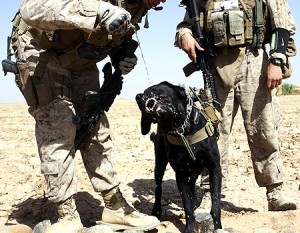Marines, Beasts and Water
BY Herschel SmithIn Scenes From Operation Khanjar II we discussed heavy battle space weight, the contribution of water to this weight, and the necessity for Marine infantry to be all male. A debate ensued concerning all of the salient points, but the truth remains that it requires young males in superior condition to sprint with body armor under fire, and carry (in many cases) more than 120 pounds of weapons, food, armor, water, ammunition and equipment for ten to twelve hours a day in more than 100 degree heat. The low hanging fruit has already been picked. There isn’t much else that can be done concerning weight with the exception of ESAPI plates, and even modifications to these won’t remove the heavy weight of water.
U.S. Marine dog handler corporal Chad Perraut, with 2nd platoon, F company, 5th battalion, 10th Marines pours water for Body, a Marine bomb sniffer patrol dog, during a patrol in southern Afghanistan. After five years coping with the most dangerous province in Iraq, the U.S. Marines have been given their next assignment: Helmund, the most dangerous province in Afghanistan.
Heavy exertion in hot weather while wearing body armor requires that the Marine carry enough to drink multiple liters of water every hour to avoid dehydration and even heat stroke. The heat is as much of an enemy as the insurgents.
After hours of ferocious fighting in southern Afghanistan, the two young US Marines desperately needed emergency medical care — and it was the heat, not the Taliban, that had finally defeated them.
Charles Auge and Edwin Saez had landed at a canal junction at dawn last Thursday as part of a major US offensive against Islamist insurgents in the key province of Helmand.
They were engaged in an intense battle through the heat of day against dozens of gunmen who were determined not to lose control of the Mian Poshtey intersection in the south of Garmsir district.
When their two-and-a-half-litre (five-US-pint) water backpacks ran out, Auge and Saez looked to restock from the bottles that Echo company from the 2/8 infantry battalion had brought with them on the helicopter assault.
But as the company came under constant fire, the supplies were limited and the water scorchingly hot when it did arrive.
“We were on the flank beside a thick grass berm, and in the middle of the day the sun was so strong and there was no shade,” Auge, 24, said. “I began to feel dizzy and everything turned white.”
Saez, 21, also became a “heat casualty” soon after, having shot at — and apparently killed — two gunmen who were firing at the Marines from behind a wall.
“I started slipping in and out of consciousness,” he said. “The water we got was so hot it burnt in my throat.”
The two Marines became so seriously ill that they were evacuated from the battlefield by Red Cross helicopters that came in under hostile fire.
They were treated with intravenous drips and ice baths, and kept under observation at a field hospital for three days before being released, now recovering from the ordeal.
Marines run through a door that they blew open with explosives after taking fire from inside a compound in Mian Poshteh, in the hot dust of Helmand.
Command knows that this is an issue and is trying to deal with it.
… we understand the number one threat here right now today is not the Taliban, it’s the heat. And as I said, it is hot as fire. Every day we’ve got helicopters, day and night, pushing all manner of logistics, but especially pallets of water to the Marines. I am more than confident — and I stay in touch with my commanders down there — I am more than confident that we’re getting the amount of water they need in a timely manner. No one is going without water.
My problem, and what I’m fussing about with my staff, is that the water’s not cold. We need to freeze that water. We need to deliver water that’s pretty well frozen. It will thaw out very quickly. So we’re working on that.
Insertion of Marines at the outset of Operation Khanjar, Marines carry water.
Failure to plan for this is stolid and inept. But there are families that are pressing for formal investigations into marches in severe heat at the beginning of Operation Khanjar. This is about as inept as the failure to plan for cold water. What would the results of such an investigation be? That the life of a Marine infantryman is hard?
The Marine logistics officers in Southern Helmand should plan better, the Marine families should drop their demands for investigations, and Marine infantry remains a young man’s job (with special emphasis on both young and man).








On July 14, 2009 at 9:11 pm, Larry said:
Given how much water modern soldiers consume, it makes me wonder how they did it in the old days, before they had plastic, etc. Didn’t they need as much water then, as now?
On July 14, 2009 at 10:51 pm, Herschel Smith said:
I think there are a number of differences, but you raise a good question. How did Patton’s troops do it in the 100 mile march to relieve Bastogne? How did they get water? Perhaps they melted snow, but that would have required them to stop, which they didn’t do. How did they do it in the campaign for North Africa? My impressions are that the North Africa campaign was much slower and less subject to temporary interruptions in logistics.
It would be good for a historian to drop by and add his knowledge.